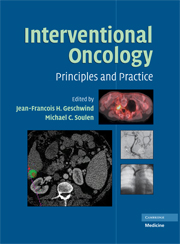Book contents
- Frontmatter
- Contents
- FOREWORD
- ACKNOWLEDGMENTS
- CONTRIBUTORS
- PART I PRINCIPLES OF ONCOLOGY
- 1 Biology of Cancer
- 2 Evaluation of the Cancer Patient
- 3 Principles of Chemotherapy
- 4 Pharmacologic Principles of Regional Therapy in the Treatment of Liver Metastases or Primary Liver Tumors
- PART II PRINCIPLES OF IMAGE-GUIDED THERAPIES
- PART III ORGAN-SPECIFIC CANCERS
- PART IV SPECIALIZED INTERVENTIONAL TECHNIQUES IN CANCER CARE
- INDEX
- Plate section
- References
1 - Biology of Cancer
from PART I - PRINCIPLES OF ONCOLOGY
Published online by Cambridge University Press: 18 May 2010
- Frontmatter
- Contents
- FOREWORD
- ACKNOWLEDGMENTS
- CONTRIBUTORS
- PART I PRINCIPLES OF ONCOLOGY
- 1 Biology of Cancer
- 2 Evaluation of the Cancer Patient
- 3 Principles of Chemotherapy
- 4 Pharmacologic Principles of Regional Therapy in the Treatment of Liver Metastases or Primary Liver Tumors
- PART II PRINCIPLES OF IMAGE-GUIDED THERAPIES
- PART III ORGAN-SPECIFIC CANCERS
- PART IV SPECIALIZED INTERVENTIONAL TECHNIQUES IN CANCER CARE
- INDEX
- Plate section
- References
Summary
“The science of today is the technology of tomorrow.”
Edward TellerInterventional radiology (IR) techniques play an important role in cancer therapy by accessing and treating tumors via image-guided methods. These methods involve both local and regional therapies, with thermal ablative technology comprising the former and intra-arterial embolization with radioactive particles the latter. Combined with systemic chemotherapy, these techniques result in increased patient survival. A more recent approach for cancer therapy involves the use of drugs that specifically target molecular, biological or physiological processes. Examples of such targets include epithelial growth factor receptor (EGFR), vascular endothelial growth factor (VEGF), protein kinases, hypoxia inducible factor (HIF), cell cycle checkpoints, apoptosis, hypoxia and angiogenesis. Drugs specific to each of these targets are currently available or are in development; some of these agents may be applicable to interventional delivery. The purpose of this chapter is to review important aspects of tumor biology that may be targeted via an interventional approach.
The clinical behavior of a tumor results from a complex set of interactions between neoplastic and non-neoplastic cells, blood vessels, blood and interstitial fluids using intercellular communication. These interactions define the tumor microenvironment, which continues to be extensively studied because there is evidence that it substantially influences tumor behavior and patient outcome (1, 2). This chapter begins with a review of the components and clinical/biological effects of hypoxia, pH, and glucose, discussed by Evans and Gatenby.
- Type
- Chapter
- Information
- Interventional OncologyPrinciples and Practice, pp. 3 - 22Publisher: Cambridge University PressPrint publication year: 2008
References
- 1
- Cited by



